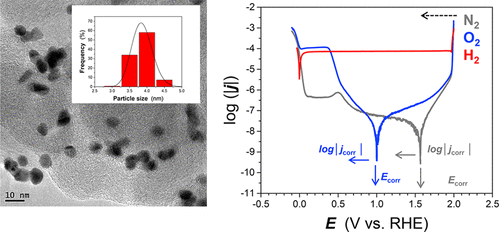当前位置:
X-MOL 学术
›
J. Phys. Chem. C
›
论文详情
Our official English website, www.x-mol.net, welcomes your
feedback! (Note: you will need to create a separate account there.)
How Stable Are Spherical Platinum Nanoparticles Applied to Fuel Cells?
The Journal of Physical Chemistry C ( IF 3.3 ) Pub Date : 2018-05-07 00:00:00 , DOI: 10.1021/acs.jpcc.7b10617 Sadaf Tahmasebi 1 , Gregory Jerkiewicz 1 , Stève Baranton 2 , Christophe Coutanceau 2 , Yoshihisa Furuya 3 , Atsushi Ohma 3
The Journal of Physical Chemistry C ( IF 3.3 ) Pub Date : 2018-05-07 00:00:00 , DOI: 10.1021/acs.jpcc.7b10617 Sadaf Tahmasebi 1 , Gregory Jerkiewicz 1 , Stève Baranton 2 , Christophe Coutanceau 2 , Yoshihisa Furuya 3 , Atsushi Ohma 3
Affiliation

|
We report on the synthesis, characterization, and degradation behavior of spherical platinum nanoparticles (Pt-NPs). The Pt-NPs were synthesized with and without carbon-support using the “water-in-oil” microemulsion method. X-ray diffraction (XRD) was used to examine their average crystallite size, which was ca. 4.0 nm. The shape, size, and size distribution of the Pt-NPs were evaluated using transmission electron microscopy (TEM); the average size was ca. 4.0 nm, thus in agreement with the XRD data. The agreement between the XRD and TEM data indicates that the Pt-NPs were single crystallites in nature. Thermogravimetric analysis (TGA) measurements were carried out to evaluate the metal loading, which was close to the target value of 40 wt %. Cyclic voltammetry (CV) experiments were performed in 0.50 M aqueous H2SO4 in the s = 1.00–50.0 mV s–1 potential scan rate to determine the specific surface area (As) of the catalysts and to assess the cleanliness of the system. The Pt surface oxide growth and reduction were successfully examined using in situ confocal Raman spectroscopy. The results allow monitoring the appearance and disappearance of crystallinity in the surface oxide layer. The stability of the catalyst was evaluated by recording 500 CV profiles in 0.50 M aqueous H2SO4 solution in the 0.05 V ≤ E ≤ 1.55 V range at s = 50.0 mV s–1. The corrosion behavior of Pt-NPs was studied using potentiodynamic polarization (PDP) measurements at s = 0.10 mV s–1 in the presence of different gaseous environments (N2(g), O2(g), or H2(g)). The nature of the dissolved gas has a profound impact on the stability/corrosion behavior of the Pt-NPs. The Pt nanocatalysts are stable in the electrolyte saturated with H2(g), undergo slight corrosion in the electrolyte saturated with N2(g), and undergo significant corrosion in the electrolyte saturated with O2(g). The carbon support also undergoes corrosion and porosity changes. The corrosive degradation of the Pt-NPs and carbon support is pronounced the most in the case of the anodic PDP. Cyclic voltammetry measurements were employed to determine the loss of the electrochemically active surface area (Aecsa) of the Pt-NPs prior to and after PDP measurements; the results correlate with the corrosion rates. The new and original results on the characterization and corrosive degradation of the Pt-NPs represent an important contribution that will benefit fuel cell science and technology.
中文翻译:

球形铂纳米颗粒应用于燃料电池的稳定性如何?
我们报告了球形铂纳米颗粒(Pt-NPs)的合成,表征和降解行为。使用“油包水”微乳液法在有碳载体和无碳载体的情况下合成了Pt-NP。X射线衍射(XRD)用于检查其平均微晶尺寸,约为。4.0纳米 Pt-NP的形状,大小和大小分布使用透射电子显微镜(TEM)进行评估;平均大小为 4.0 nm,因此与XRD数据一致。XRD和TEM数据之间的一致性表明,Pt-NPs本质上是单晶。进行热重分析(TGA)测量以评估金属负载,该负载接近目标值40 wt%。循环伏安法(CV)实验在0.50 M的H 2水溶液中进行s中的SO 4 = 1.00–50.0 mV s –1电位扫描速率,以确定催化剂的比表面积(A s)并评估系统的清洁度。使用原位共聚焦拉曼光谱法成功地检测了Pt表面氧化物的生长和还原。结果允许监测表面氧化物层中结晶度的出现和消失。催化剂的稳定性通过在0.50M的水性记录500条CV曲线ħ评价2 SO 4中的0.05 V≤溶液Ë在≤1.55 V范围内小号= 50.0毫伏小号-1。在存在不同气体环境(N 2(g),O 2(g)或H 2(g))的情况下,使用电位动力学极化(PDP)在s = 0.10 mV s –1下对Pt-NPs的腐蚀行为进行了研究。)。溶解气体的性质对Pt-NPs的稳定性/腐蚀行为有深远的影响。Pt纳米催化剂在H 2(g)饱和的电解质中稳定,在N 2(g)饱和的电解质中略有腐蚀,在O 2饱和的电解质中显着腐蚀。(G)。碳载体也经历腐蚀和孔隙率变化。在阳极PDP的情况下,Pt-NP和碳载体的腐蚀降解最为明显。循环伏安法测量用于确定PDP测量之前和之后Pt-NPs的电化学活性表面积(A ecsa)的损失。结果与腐蚀速率相关。关于Pt-NPs的表征和腐蚀降解的新的和原始的结果代表了将有助于燃料电池科学和技术的重要贡献。
更新日期:2018-05-07
中文翻译:

球形铂纳米颗粒应用于燃料电池的稳定性如何?
我们报告了球形铂纳米颗粒(Pt-NPs)的合成,表征和降解行为。使用“油包水”微乳液法在有碳载体和无碳载体的情况下合成了Pt-NP。X射线衍射(XRD)用于检查其平均微晶尺寸,约为。4.0纳米 Pt-NP的形状,大小和大小分布使用透射电子显微镜(TEM)进行评估;平均大小为 4.0 nm,因此与XRD数据一致。XRD和TEM数据之间的一致性表明,Pt-NPs本质上是单晶。进行热重分析(TGA)测量以评估金属负载,该负载接近目标值40 wt%。循环伏安法(CV)实验在0.50 M的H 2水溶液中进行s中的SO 4 = 1.00–50.0 mV s –1电位扫描速率,以确定催化剂的比表面积(A s)并评估系统的清洁度。使用原位共聚焦拉曼光谱法成功地检测了Pt表面氧化物的生长和还原。结果允许监测表面氧化物层中结晶度的出现和消失。催化剂的稳定性通过在0.50M的水性记录500条CV曲线ħ评价2 SO 4中的0.05 V≤溶液Ë在≤1.55 V范围内小号= 50.0毫伏小号-1。在存在不同气体环境(N 2(g),O 2(g)或H 2(g))的情况下,使用电位动力学极化(PDP)在s = 0.10 mV s –1下对Pt-NPs的腐蚀行为进行了研究。)。溶解气体的性质对Pt-NPs的稳定性/腐蚀行为有深远的影响。Pt纳米催化剂在H 2(g)饱和的电解质中稳定,在N 2(g)饱和的电解质中略有腐蚀,在O 2饱和的电解质中显着腐蚀。(G)。碳载体也经历腐蚀和孔隙率变化。在阳极PDP的情况下,Pt-NP和碳载体的腐蚀降解最为明显。循环伏安法测量用于确定PDP测量之前和之后Pt-NPs的电化学活性表面积(A ecsa)的损失。结果与腐蚀速率相关。关于Pt-NPs的表征和腐蚀降解的新的和原始的结果代表了将有助于燃料电池科学和技术的重要贡献。











































 京公网安备 11010802027423号
京公网安备 11010802027423号